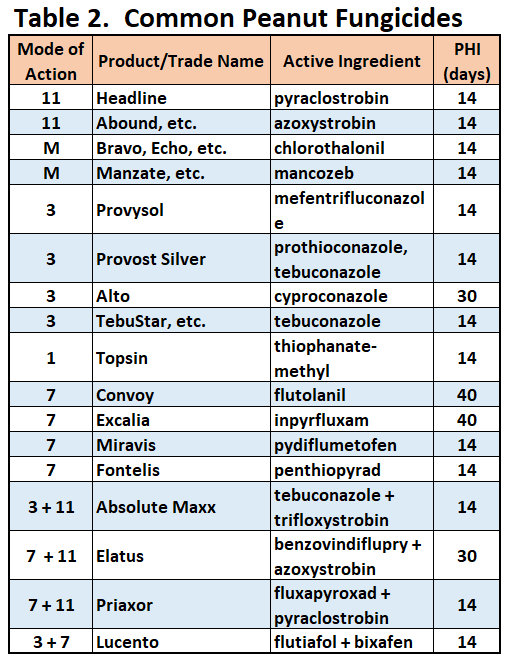Maturity Update
The aGDD Tracker below shows the number of adjusted Growing Degree Days (aGDDs) accumulated by 80 fictional fields (8 locations x 10 planting dates) as of 9/19/24. Real temperature and rainfall data from each location is used as well as common soil types for the areas (Jay – sandy loam, Marianna – loamy sand, Marianna Irrigated – sand, Monticello – loamy sand, Live Oak and Bronson – sand). Peanuts reach physiological maturity after the accumulation of approximately 2500 Growing Degree Days and the aGDD Tracker quantifies their progress. Use the Tracker to approximate how your fields are progressing by following the field that are the most similar to yours in terms of planting date, location and irrigation status. If the aGDD value shown for your field is black (under 2300), it’s probably not time to dig. If it’s yellow (between 2300 and 2500), you’re getting close; it’s time to pull samples and pod-blast to fine tune your harvest timing. Orange (2500+) means it’s almost certainly time to harvest, but pod-blasting is always the best way to know for sure. The fields shown in red are likely well past optimum harvest time but left on the aGDD Tracker for comparison sake.
For more precise tracking of your fields, go to PeanutFARM.org and set up your fields in the system. You will be able to enter field specific rainfall/irrigation data and soil type. Temperature data will come from the closest FAWN weather station. If you are interested in setting up your own fields on PeanutFARM.org, don’t hesitate to contact me for assistance.
aGDD Tracker for the Florida Peanut Producing Region – 9/19/24 edition
Table 1. The aGDD Tracker is compiled from data generated by PeanutFARM.org. The dark blue bars, in the cells behind the aGDD values, indicate progress towards 2500 aGDDs. The bar extends to the right as aGDDs are accumulated. The entire cell will be dark blue when a field has accumulated 2500 aGDDs. It is recommended that fields be sampled and exact days-to-harvest be determined via pod-blasting once a field shows approximately 2300 on the aGDD Tracker.
Even though the Panhandle has received some much needed rainfall over the past two weeks, we still see the irrigated fields significantly outpacing the rain-fed fields in their progression towards 2500 aGDDs. Irrigated fields are approximately 400 aGDDs ahead of their rain-fed counter parts. Given the current average rate of accumulation, that’s approximately 3 weeks difference in number of calendar days from planting to maturity. Please remember, that 3 week difference number, is bases on a comparison of average performance of fictional fields – it’s pretty useless in real life except to help make the point that drought stress can really slow down the rate at which a field matures. Please keep this in mind when planning harvest timing for some of those fields that spent all August with their leaves folded “praying for rain“.
The aGDD Tracker is showing rain-fed fields tracking about with the calendar (140 DAP is roughly matching 2500 aGDDs). Personal observation – the fields from which I’ve pod-blasted samples seem to be running behind the calendar anywhere from 5 to 10 days. If the calendar and/or the aGDD Tracker indicate a field is close, it’s always a good idea to have a sample blasted and boarded just make sure you have the complete picture. There no sense in giving up yield and grade if you don’t have to.
As they always do, the conversations about when to dig are becoming more complicated. There are several important considerations to factor into determining digging dates. Ideally, canopies are good and field maturity progression is monitored using the profile board as they near the 130-140 days after planting (DAP) window. However, growers are not always dealing with ideal conditions at harvest. If white mold levels are reaching 50%, it is important not to delay harvest. Leaf spot defoliation is another huge concern for fields, sometimes before reaching the desired 130-140 DAP range for profiling or even a more specific date following the board. If defoliation has reached 50%, it’s time to set a digging date, sooner than later. Levels beyond 60% at digging will likely result in yield loss.
If you decide to apply a fungicide before harvest, it is important to follow the label and all pre-harvest interval restrictions associated with the different products. Table 2 below compares common peanut fungicides with different modes of action and pre-harvest intervals (PHI). Note, this is not an exhaustive list and does not replace the information on the product labels.
- Peanut Maturity Update – 10/9/25 - October 10, 2025
- Fall Can be a Great Time for Vegetation Management - October 3, 2025
- Peanut Maturity Update – 9/25/25 Edition - September 26, 2025

